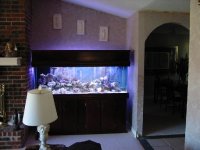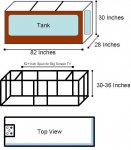I am considering building a plywood tank in the 250 gallon range. I have some structural/materials questions. This is a long post, but anywhere you could help out would be appreciated. Attached (hopefully) are two pictures, one of the 135 where the tank is going, and the other is a quick drawing of the tank, stand, and overflows. Take a look at them to understand the questions below.
Here are my tank building questions:
I am going to use AC plywood. Does it have to be Marine grade/Outdoor grade? I’m thinking both of those mean the wood was pressure treated, and Marine grade is stronger with less internal voids.
The price Lowe’s gave me was $82/sheet for ¾ marine grade AB plywood (didn’t have AC) and $59.56 for 1/2, everyone else is paying around $50. Anyone know a good source near Dallas?
I’m guessing I need at least 1” plywood. What do you guys think? Could I go with ¾”, do I need to laminate two ½” sheets, or do I need two ¾ sheets laminated together?
For the glass, I think it needs to be 5/8 or possibly ¾. If I go with ¾ I will probably make the tank a few inches taller. What would you guys recommend? Tempered or plate? Can I use 5/8 tempered with a slightly taller tank?
Does the glass need to fill the front wall completely minus a ¼ inch gap? The reason I am asking, I want to have a 5-6 inch wood boarder on the bottom to cover up the DSB. Does the glass need to start at the bottom or can it start say 4 inches off the bottom of the tank? Any structural issues I’m not aware of here?
I want the Overflow to run down to the bottom of the tank with bulkheads drilled in bottom plywood I won’t have room behind the tank, and I want the tank to be as large as possible. Will Acrylic stick to the epoxy paint? I’m guessing you would put this in after painting and before putting silicone in all the joints? Anyone have experience here?
I am worried about scratching the epoxy, and plan to coat the inside of the tank with ¼ inch Plexiglas. For those of you that have done it, did you bond the pieces together or just set them against the wall/bottom? What did you do about the silicone joints? Is water getting behind the acrylic a concern?
Here are my Stand questions:
For the stand, I’m planning to use 1” square steel tubing. Looking at my stand design, I don’t have any cross braces along the middle 52 inches. I did this so the cabinet I’m building could also house a big screen TV. I plan to skin it with ¾ plywood on top to distribute the weight. Do you think the stand will hold? Does it need additional supports? I’m guessing the people who buy my house won’t want two huge fish tanks built into the wall. This way, it can be converted into a built in media center. Any input on the stand would be appreciated.
I’m putting the glass on two sides, and the overflow in on one side. This is just in case I decide to make this into a room divider of my next house. I can add another glass section to the back. (I say that now, but will probably just build an even bigger tank!) The dark blue will be two 1” returns, one to a couple spray bars along the back of the rock work, and the other pushing a lot of water across the tank. I will probably get an
Ampmaster 3000 to run the system. For the other three I was thinking about using 3-1” drains. Then I could add some power heads at the other end for wave action. Any flaws here? I have seen people just put bulkheads in the bottom of the tank for recirculation or return plumbing, but that scares me. Those bulkheads leak, and I’m draining the entire tank. Not worth the risk in my mind.
Thanks for reading the post, and I look forward to your comments. If I build this monster, I plan to track my progress on my website listed in my signature.
Thanks,
Sam
Here are my tank building questions:
I am going to use AC plywood. Does it have to be Marine grade/Outdoor grade? I’m thinking both of those mean the wood was pressure treated, and Marine grade is stronger with less internal voids.
The price Lowe’s gave me was $82/sheet for ¾ marine grade AB plywood (didn’t have AC) and $59.56 for 1/2, everyone else is paying around $50. Anyone know a good source near Dallas?
I’m guessing I need at least 1” plywood. What do you guys think? Could I go with ¾”, do I need to laminate two ½” sheets, or do I need two ¾ sheets laminated together?
For the glass, I think it needs to be 5/8 or possibly ¾. If I go with ¾ I will probably make the tank a few inches taller. What would you guys recommend? Tempered or plate? Can I use 5/8 tempered with a slightly taller tank?
Does the glass need to fill the front wall completely minus a ¼ inch gap? The reason I am asking, I want to have a 5-6 inch wood boarder on the bottom to cover up the DSB. Does the glass need to start at the bottom or can it start say 4 inches off the bottom of the tank? Any structural issues I’m not aware of here?
I want the Overflow to run down to the bottom of the tank with bulkheads drilled in bottom plywood I won’t have room behind the tank, and I want the tank to be as large as possible. Will Acrylic stick to the epoxy paint? I’m guessing you would put this in after painting and before putting silicone in all the joints? Anyone have experience here?
I am worried about scratching the epoxy, and plan to coat the inside of the tank with ¼ inch Plexiglas. For those of you that have done it, did you bond the pieces together or just set them against the wall/bottom? What did you do about the silicone joints? Is water getting behind the acrylic a concern?
Here are my Stand questions:
For the stand, I’m planning to use 1” square steel tubing. Looking at my stand design, I don’t have any cross braces along the middle 52 inches. I did this so the cabinet I’m building could also house a big screen TV. I plan to skin it with ¾ plywood on top to distribute the weight. Do you think the stand will hold? Does it need additional supports? I’m guessing the people who buy my house won’t want two huge fish tanks built into the wall. This way, it can be converted into a built in media center. Any input on the stand would be appreciated.
I’m putting the glass on two sides, and the overflow in on one side. This is just in case I decide to make this into a room divider of my next house. I can add another glass section to the back. (I say that now, but will probably just build an even bigger tank!) The dark blue will be two 1” returns, one to a couple spray bars along the back of the rock work, and the other pushing a lot of water across the tank. I will probably get an
Ampmaster 3000 to run the system. For the other three I was thinking about using 3-1” drains. Then I could add some power heads at the other end for wave action. Any flaws here? I have seen people just put bulkheads in the bottom of the tank for recirculation or return plumbing, but that scares me. Those bulkheads leak, and I’m draining the entire tank. Not worth the risk in my mind.
Thanks for reading the post, and I look forward to your comments. If I build this monster, I plan to track my progress on my website listed in my signature.
Thanks,
Sam







